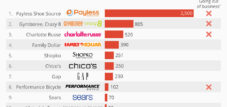Retailers Lose Billions to Theft, Fraud and Human Error
Language selection 📢
Published on: January 12, 2019 / update from: January 12, 2019 - Author: Konrad Wolfenstein
Being a retailer is not easy these days. Aside from the obvious problem of having to compete with thousands of online retailers, they also have to contend with shoplifters, dishonest employees and organized criminals. According to a report from the National Retail Federation, U.S. retailers lose an average of 1.33 percent of their sales through inventory depletion, that is, inventory losses associated with theft, shoplifting, error or fraud. Which cost the US retail economy a total of $46.8 billion in 2017.
After surveying 63 retailers in spring 2018, the NRF found that shoplifting (including organized retail crime) was the largest source of inventory loss in 2017, accounting for an average of 35.7 percent of shrinkage. However, internal theft by employees and others was a close second, which is why most retailers take measures to ensure the integrity of potential employees, such as criminal convictions, employment history verification, personal references and drug screening.
Being a brick-and-mortar retailer isn't easy these days. Aside from the obvious problem of having to compete with thousands of online retailers, you also must deal with shoplifters, dishonest employees and organized criminals taking a bite out of your bottom line. According to a report by the National Retail Federation , US retailers lose 1.33 percent of sales on average to inventory shrink, ie a loss of inventory related to theft, shoplifting, error or fraud, costing the US retail economy a total of $46.8 billion in 2017 .
Having surveyed 63 retailers in the spring of 2018, the NRF found that shoplifting by external actors (including organized retail crime) was the biggest source of inventory loss in 2017, accounting for 35.7 percent of shrinkage on average. Internal theft by employees and others was close behind however, which is why most retailers take measures to ensure the integrity of potential employees, such as criminal conviction checks, verification of employment history, personal references and drug screenings.





























